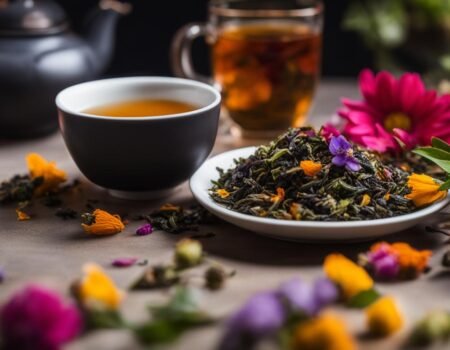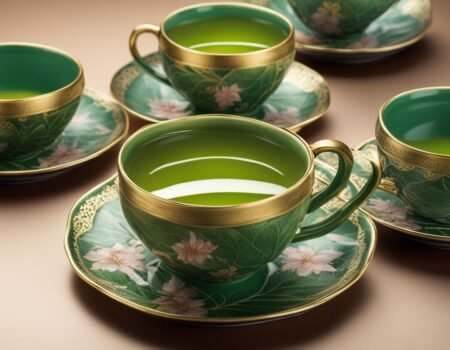
Discover Traditional Chai: Authentic Indian Chai Recipes
Welcome to our exploration of traditional Indian chai, where we dive into the aromatic world of authentic masala chai recipes. Prepare to tantalize your taste buds and experience the rich flavors of this beloved Indian beverage.
Traditional Indian chai, also known as masala chai, is a delightful concoction deeply rooted in Indian culture. Made with a blend of aromatic spices, milk, and tea leaves, this comforting beverage has been a staple in Indian households for generations.
Join us on a journey through the history, culture, and techniques of making traditional Indian chai. From the selection of spices to the choice of tea leaves, we’ll guide you through each step to ensure an authentic and satisfying chai tea experience.
Key Takeaways:
- Discover the rich flavors of traditional Indian chai with authentic masala chai recipes.
- Explore the history and cultural significance of chai tea in Indian cuisine.
- Learn step-by-step techniques for making chai tea at home, including different preparation methods and variations.
- Uncover the aromatic spices used in chai tea and how they contribute to its distinct flavor profile.
- Choose the right tea leaves for your homemade chai tea and follow classic chai tea instructions.
What is Chai Tea?
Chai tea, also known as masala chai, is a spiced tea that originated in India. It is a popular beverage in Indian households and is often served to guests as a gesture of hospitality. The word “chai” simply means tea in Hindi, and the term “masala chai” refers to the blend of spices used to make the tea.
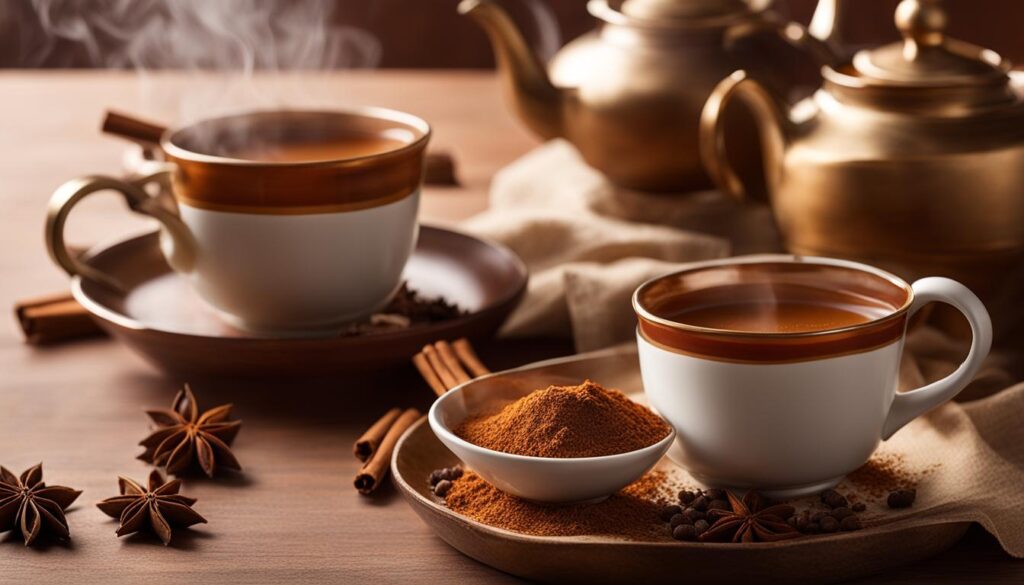
The history of chai tea dates back thousands of years, with its origins rooted in Ayurvedic practices. Traditional chai tea is made by simmering a blend of aromatic spices, milk, and tea leaves. The spices commonly used in chai tea include cinnamon, cardamom, cloves, ginger, and black peppercorns, which give the tea its unique and complex flavor profile.
“Chai tea is not just a beverage; it is a cultural experience. It represents warmth, comfort, and hospitality in Indian culture.”
The process of making chai tea involves simmering the spices, milk, and tea leaves together to infuse the flavors and create a rich and creamy beverage. The tea is often sweetened with sugar or other sweeteners to enhance its taste. Each region in India has its own variation of chai tea, with slight differences in the choice of spices and preparation methods.
Chai Tea: A Cultural Experience
Chai tea holds a special place in Indian culture. It is not just a beverage, but a cultural experience that is deeply ingrained in the daily lives of millions of people. Chai tea is commonly consumed in the morning or evening as a way to start the day or unwind after a long day of work.
The act of brewing chai tea itself is a ritualistic process. It involves carefully selecting the spices, grinding them, and simmering them in milk and water. The aroma that fills the air while making chai tea is enchanting and creates a sense of comfort and anticipation.
Chai tea is often shared with friends, family, and even strangers, as a symbol of warmth, welcome, and hospitality. It is offered to guests as a gesture of respect and friendship, and it is considered impolite to refuse a cup of chai tea when it is offered.
Chai Tea: Beyond Borders
Chai tea has gained popularity beyond India and is now enjoyed by people around the world. Its unique blend of spices and comforting qualities have made it a favorite beverage among tea lovers everywhere. In cafes and coffee shops, chai tea lattes have become a staple on the menu, offering a cozy and indulgent alternative to traditional coffee drinks.
With its rich history and cultural significance, chai tea continues to captivate the hearts and taste buds of people worldwide. Whether enjoyed in the traditional Indian way or in a modern adaptation, chai tea offers a delightful and aromatic experience that is sure to leave a lasting impression.
How to Make Chai Tea at Home
Making chai tea at home is a delightful experience that allows you to enjoy the rich flavors of this traditional Indian beverage. To create the perfect cup of homemade chai, you’ll need a few essential ingredients and the right techniques. Here’s a step-by-step guide to help you master the art of chai tea preparation.
Gather Your Traditional Chai Ingredients
To make authentic Indian chai, you’ll need the following ingredients:
- 2 cups of water
- 1 cup of milk
- 2 tablespoons of loose black tea leaves
- 1-inch piece of fresh ginger, grated
- 4-6 green cardamom pods, lightly crushed
- 4-6 whole cloves
- 1 cinnamon stick
- 1-2 teaspoons of granulated sugar (adjust to taste)
Feel free to customize the recipe by adding or reducing the amount of spices or sweetener. Now, let’s dive into the preparation techniques.
Chai Preparation Techniques
Follow these steps to make a delicious cup of homemade chai:
- In a saucepan, bring the water to a boil.
- Add the tea leaves, ginger, cardamom pods, cloves, and cinnamon stick to the boiling water.
- Reduce the heat to low and simmer the mixture for 5-10 minutes, allowing the flavors to infuse.
- Add the milk to the saucepan and simmer for an additional 5 minutes.
- Strain the chai tea into cups, discarding the tea leaves and spices.
- Sweeten your chai tea with sugar or any preferred sweetener, stirring until dissolved.
- Serve hot and enjoy the comforting flavors of homemade chai!
Experiment with different variations by adjusting the amount of spices or adding other ingredients like black peppercorns or fennel seeds. The possibilities are endless!
| Pro Tip |
|---|
| For a creamier texture, you can use half-and-half or condensed milk instead of regular milk. |
Now that you have mastered the art of making chai tea at home, you can savor this delightful beverage whenever you desire. Whether you enjoy it in the morning to kickstart your day or as an afternoon pick-me-up, homemade chai tea is a comforting and delicious treat.
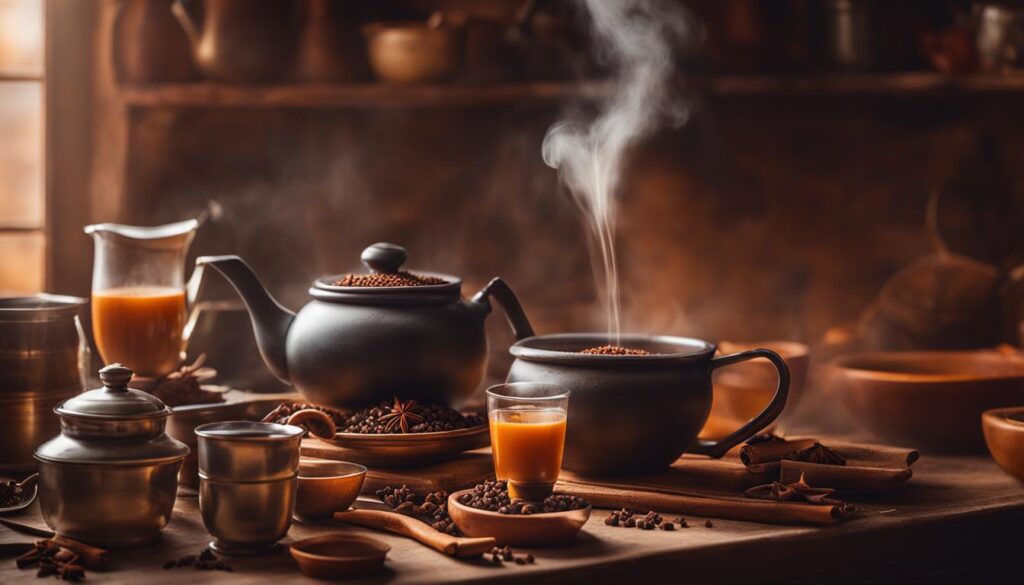
Chai Tea Spices
When it comes to the rich and aromatic flavor of chai tea, the secret lies in the carefully selected blend of spices. These spices add depth and complexity to the tea, creating a truly delightful beverage. Let’s take a closer look at some of the common spices used in chai tea:
- Cinnamon: Known for its sweet and warm taste, cinnamon adds a comforting touch to chai tea.
- Cardamom: With its unique and slightly citrusy flavor, cardamom provides a refreshing twist to the traditional chai tea recipe.
- Cloves: The strong and pungent flavor of cloves lends a distinct spiciness to the tea, balancing out the sweetness.
- Ginger: Ginger adds a subtle heat and a touch of earthiness to chai tea, making it a perfect ingredient for those who enjoy a bit of kick in their beverage.
- Black peppercorns: These tiny black pearls bring a hint of heat and a mild kick to the chai tea, creating a well-rounded flavor profile.
Combining these spices in the right proportions is key to achieving the perfect balance of flavors in chai tea. Some recipes may also include additional spices like nutmeg, fennel seeds, or star anise for an extra layer of complexity.
“The secret to a truly divine chai tea lies in the spices. The combination of cinnamon, cardamom, cloves, ginger, and black peppercorns creates a symphony of flavors that dance on your palate.”
To brew the best chai tea, it’s important to understand the brewing methods commonly used in India. One popular method is the stovetop brewing method, where the spices, tea leaves, and milk are simmered together to extract maximum flavor. This method allows the spices to infuse gradually, resulting in a rich and aromatic brew.
Another popular brewing method is the decoction method, where a concentrated spice-infused liquid called “chai ka masala” is prepared in advance. This liquid can then be added to brewed tea and milk to create a quick and convenient cup of chai.
| Brewing Method | Characteristics |
|---|---|
| Stovetop Method | Slow, gradual infusion of flavors |
| Decoction Method | Convenient and quick |
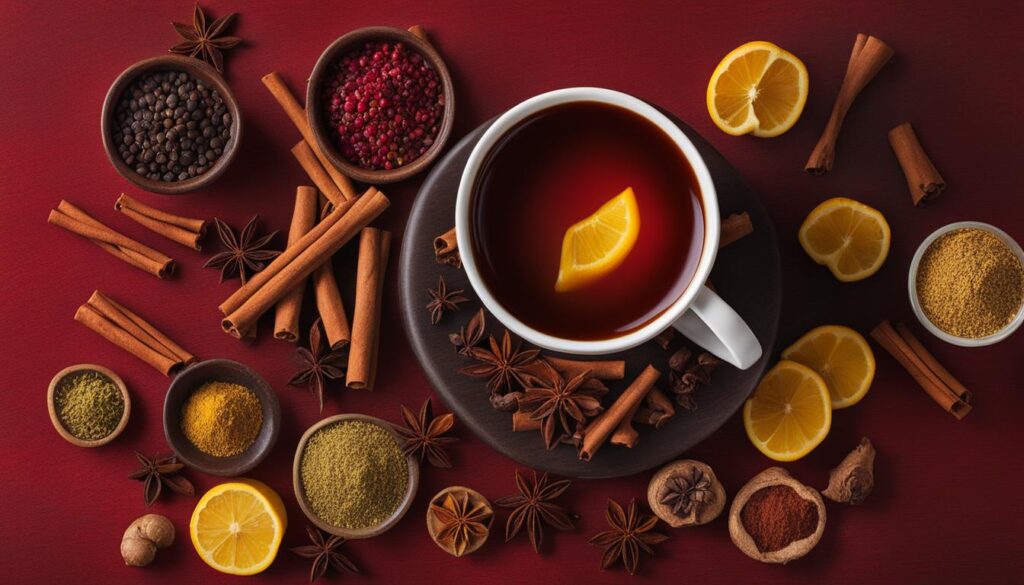
The choice of spices and brewing method ultimately depends on personal preference and the desired flavor profile. Experimenting with different combinations and techniques will allow you to discover your own unique version of chai tea.
What Tea Should You Use to Make Chai Tea at Home?
When it comes to making authentic chai tea at home, the choice of tea leaves is crucial. Traditionally, black tea is used as the base for chai tea preparations. Black tea provides a robust and bold flavor that pairs perfectly with the aromatic spices and creamy milk. However, within the realm of black tea, there are different varieties to choose from. Let’s explore some of the popular options:
- Assam Tea: This bold and malty tea hails from the Assam region in India. It lends a strong and full-bodied character to chai tea, making it a popular choice for those who prefer a robust brew.
- Darjeeling Tea: Known as the “champagne of teas,” Darjeeling tea is light and aromatic, with floral and fruity notes. It adds elegance and a delicate touch to chai tea, perfect for those who prefer a milder flavor.
- Ceylon Tea: Ceylon tea, grown in Sri Lanka, offers a bright and brisk flavor profile with citrusy notes. It adds a refreshing twist to chai tea, making it a great choice for those who enjoy a zesty and lively cup.
Ultimately, the choice of tea leaves depends on your personal taste preferences. You can experiment with different varieties to discover the perfect balance of flavors that suits your palate. Whether you opt for the boldness of Assam, the delicacy of Darjeeling, or the vibrancy of Ceylon, your homemade chai tea is sure to be a delightful treat.
Now that we’ve explored the different types of tea leaves, let’s dive into the classic chai tea instructions:
- Start by boiling water in a saucepan.
- Add your choice of tea leaves and simmer for a few minutes, allowing the flavors to infuse into the water.
- Next, add the aromatic spices such as cinnamon, cardamom, cloves, ginger, and black peppercorns. The quantity of spices can vary according to your taste preferences.
- Pour in the milk and bring the mixture to a gentle boil, stirring occasionally to prevent it from sticking to the pan.
- Once the chai tea reaches your desired strength, strain it into your favorite cup or teapot.
- You can sweeten your chai tea with granulated white sugar, natural cane sugar, maple syrup, or honey, depending on your preference.
- Sit back, relax, and savor the warm and comforting flavors of your homemade chai tea!
So, go ahead and embark on a flavorful journey with the perfect tea leaves and classic chai tea instructions. Enjoy the aromatic spices, the creamy milk, and the comforting embrace of this traditional Indian beverage!
Benefits of Using Different Tea Leaves in Chai Tea
Each type of tea leaf used in chai tea brings its own unique characteristics, resulting in a diverse range of flavors and experiences. Here are some benefits of using different tea leaves:
| Tea Leaf | Benefits |
|---|---|
| Assam Tea | Provides a bold and robust flavor that pairs well with the spicy chai blend. |
| Darjeeling Tea | Brings a delicate and floral touch to chai tea, adding a subtle elegance to the brew. |
| Ceylon Tea | Offers a bright and lively taste, infusing the chai with a refreshing citrusy note. |
How to Sweeten Chai
Sweetening chai tea is a delightful way to enhance its flavors and make it more enjoyable to drink. There are several options available when it comes to sweetening chai, allowing you to customize the taste according to your preferences. Let’s explore some methods and sweeteners you can use to sweeten your chai tea.
Granulated White Sugar
The most common and easily accessible sweetener for chai tea is granulated white sugar. It dissolves quickly and blends well with the flavors of the tea and spices. Start by adding a teaspoon of sugar to your cup of chai and adjust according to your taste. Remember, you can always add more sugar, but you can’t take it out once it’s been added.
Natural Cane Sugar
If you prefer a more natural alternative to granulated white sugar, you can sweeten your chai with natural cane sugar. It has a slightly deeper flavor and can add a subtle caramel-like taste to your tea. Use the same proportion as granulated white sugar and adjust according to your desired sweetness.
Maple Syrup or Honey
For those looking for a healthier and more unique sweetener, you can try using maple syrup or honey. These natural sweeteners bring their own distinct flavors to the chai, adding a touch of richness and complexity. Start with a small amount and adjust to taste, as they can be quite potent.
Experiment with different sweeteners and find the one that perfectly complements your chai tea. Remember, the sweetness of chai is a personal preference, so feel free to adjust the amount of sweetener according to your taste. Whether it’s the classic granulated white sugar or a more adventurous choice like maple syrup, sweetening chai tea can elevate your tea-drinking experience.
Conclusion
In conclusion, our exploration of traditional Indian chai tea has shown us the depth of flavor and cultural significance that this beloved beverage holds. By following the authentic Indian chai recipes, you can create a cup of chai that transports you to the bustling streets of India.
But our journey doesn’t end here. There are countless regional chai recipes from India that offer unique flavor combinations and variations. From the spiced richness of Mumbai’s cutting chai to the floral notes of Kashmiri pink tea, the world of chai is ripe with exploration and experimentation.
So grab your favorite blend of tea leaves, gather your spices, and dive into the wonderful world of traditional Indian chai. Let your taste buds guide you as you discover the perfect balance of flavors that suits your palate. And remember, whether you’re sipping on a steaming cup of masala chai or a refreshing iced chai latte, every sip is a moment of connection to the vibrant culture and heritage of India.
FAQ
What is traditional Indian chai?
Traditional Indian chai, also known as masala chai, is a rich and flavorful tea that is deeply rooted in Indian culture. It is made with a blend of aromatic spices, milk, and tea leaves.
How do you make chai tea at home?
Making chai tea at home is easier than you might think. You’ll need a few key ingredients like milk, tea leaves, and a blend of spices. Simmer these ingredients together to infuse the flavors and create a rich and creamy beverage.
What spices are used in chai tea?
Some common spices used in chai tea include cinnamon, cardamom, cloves, ginger, and black peppercorns. These spices add depth and complexity to the tea, giving it its distinct flavor.
What type of tea leaves should I use for chai?
Traditionally, black tea is used in chai tea preparations. There are different types of black tea available, such as Assam, Darjeeling, and Ceylon, each with its own unique flavor profile.
How do I sweeten chai tea?
Sweetening chai tea is a matter of personal preference. You can use granulated white sugar, natural cane sugar, maple syrup, or honey to sweeten your chai tea. Experiment to find the right amount of sweetness for your taste.
Can you customize chai tea?
Absolutely! Chai tea is incredibly versatile, allowing you to customize it to your liking. You can experiment with different spices, tea leaves, and sweeteners to create your own unique version of this classic beverage.
What is the significance of chai tea in Indian cuisine?
Chai tea holds a special place in Indian culture and is often served to guests as a gesture of hospitality. It is a beloved beverage that is enjoyed at any time of the day, providing comfort and warmth.
Are there regional variations of chai tea in India?
Yes, there are regional variations of chai tea in India. Each region has its own unique flavors and combinations, offering a diverse range of chai experiences to explore.





